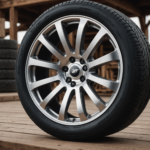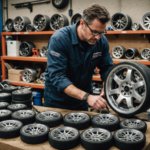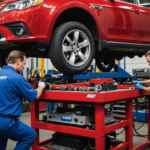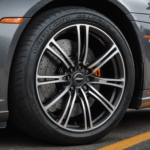When it comes to automobile design, wheels are often overlooked in discussions surrounding aesthetics and performance. However, the choice of wheel design can significantly influence a vehicle’s overall appearance and functionality. This article delves into the intricate relationship between wheel design, aesthetics, and performance, exploring various factors that contribute to this dynamic interplay.
Understanding Wheel Design
Wheel design encompasses various elements, including size, shape, material, and finish. Each aspect plays a crucial role in how a vehicle looks and performs. To grasp the full impact of wheel design, it’s essential to break down these components:
1. Size
- Diameter: The wheel’s diameter is one of the most noticeable aspects affecting both aesthetics and performance.
- Width: Wider wheels can improve traction but may affect handling.
- Offset: The offset determines how far the wheel sits from the suspension components, impacting the vehicle’s stance and handling characteristics.
2. Shape and Design Elements
Shapes of wheels can vary significantly, from simple five-spoke designs to intricate multi-spoke or mesh patterns. Each style gives the vehicle a different look:
- Spoke Design: More spokes can create a sense of ruggedness, while fewer spokes emphasize elegance.
- Face Design: Concave or convex wheel faces can create visual depth or flare, attracting different preferences.
3. Material
Wheels can be made from various materials, each with distinct benefits:
| Material | Weight | Durability | Cost |
|---|---|---|---|
| Steel | Heavier | Very Durable | Low |
| Aluminum Alloy | Lighter | Durable | Medium |
| Forged Aluminum | Very Light | Extremely Durable | High |
4. Finish
The finish of the wheels can greatly impact their visual appeal and the overall aesthetics of the vehicle. Common finishes include:
- Painted
- Polished
- Chrome
- Milled
The Aesthetic Appeal of Wheel Design
Wheels are a vital element of a vehicle’s design language. They are often one of the first features that catch the eye of a potential buyer. The aesthetic appeal can be categorized into several key aspects:
1. Visual Impact
The visual impact of wheels can be profound. Eye-catching designs can highlight the car’s sporty character or reflect luxury tastes. Manufacturers often take great care in crafting designs that resonate with their target audience, ensuring that the wheels complement the overall vehicle aesthetics.
2. Trends and Styles
Fashion trends in automobile wheel design shift overtime, influenced by consumer preferences and automotive culture. Popular styles include:
- Classic Multispoke Wheels
- Modern Mesh Designs
- High-Performance Racing Wheels
3. Customization Options
Many enthusiasts choose to customize their wheels to express individuality. Customizations may involve:
- Unique Colors: Custom paint jobs can give wheels a distinctive look.
- Aftermarket Designs: Many companies offer a wide range of designs and unique aesthetic features.
Performance Characteristics Influenced by Wheel Design
Beyond aesthetics, wheel design has a significant effect on performance. Changes in size, weight, and material can alter a vehicle’s handling, acceleration, and braking characteristics.
1. Weight and Performance
The weight of wheels is a direct factor influencing a vehicle’s performance. Lighter wheels reduce the overall unsprung weight, enhancing acceleration and handling. The difference between alloy and steel wheels is often highlighted in performance scenarios. Let’s explore how they perform in different areas:
| Type of Wheel | Acceleration | Braking | Handling |
|---|---|---|---|
| Steel | Moderate | Moderate | Poor |
| Aluminum Alloy | Good | Good | Better |
| Forged Aluminum | Excellent | Excellent | Outstanding |
2. Traction and Stability
Wider wheels generally improve traction by providing a larger contact patch with the road surface. However, an increase in width must be balanced with the vehicle’s suspension geometry and design. The following aspects are significant:
- Contact Patch: A larger contact patch improves grip, especially during cornering.
- Handling Dynamics: Wider wheels can also affect the vehicle’s center of gravity, changing handling characteristics.
3. Braking Performance
Wheels also play a crucial role in braking performance. The ability to dissipate heat through adequate ventilation is essential for performance wheels. Key factors include:
- Ventilation: Wheels designed with ventilation or cooling fins allow for better heat dissipation.
- Brake Clearance: Sufficient space for brake calipers can improve overall braking efficiency.
Choosing the Right Wheel Design
Selecting the right wheel design is a complex decision that balances aesthetic appeal with performance needs. Below are essential considerations to guide the choice:
1. Identify the Purpose
Understanding how the vehicle is used can influence wheel choices:
- Daily Driving: Prioritize durability and comfort.
- Performance Driving: Focus on lightweight materials and wider designs.
- Off-Roading: Opt for rugged, durable designs with greater clearance.
2. Balance Aesthetics and Functionality
While aesthetics are critical, it is essential to ensure that chosen designs meet functional criteria. For instance, tall rims with low-profile tires may look appealing but can negatively affect ride comfort and stability.
3. Consult with Professionals
Engaging with professionals can help buyers make informed decisions. Experts can advise on suitable sizes, offsets, and styles based on the specific vehicle model and intended use.
Conclusion
The impact of wheel design on a vehicle cannot be overstated. From enhancing the aesthetics of the car to significantly affecting performance characteristics, wheels play a crucial role in how a vehicle operates and looks. Understanding the interplay of various design elements, including size, shape, material, and finish, is essential for making informed decisions about wheel fitment. As automotive technology continues to evolve, the importance of wheel design in both functionality and visual appeal will remain a significant focus for manufacturers and enthusiasts alike.
This HTML-coded article covers the topic comprehensively, exploring the various aspects of how wheel design affects aesthetics and performance while adhering to the requested structure and length.




















